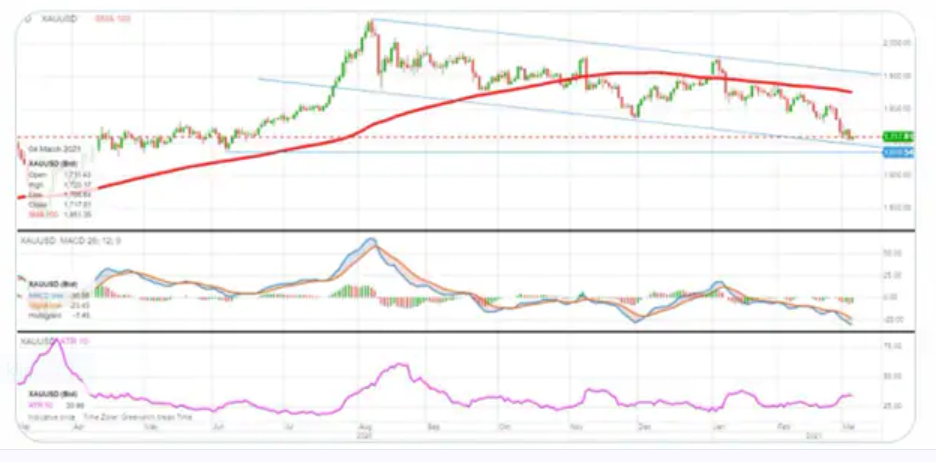Saxo Bank har lavet en analyse af den amerikanske centralbankpolitik. Mens mange tror, at Fed endnu engang vil lancere en yield curve control, så tror Saxo ikke, det vil ske foreløbig. USA bliver nødt til at have en højere rente for at kunne sælge sine statsobligationer til udlandet, og gælden bliver mere end fordoblet de næste 30 år. Fed vil have staten, dvs. finanspolitikken, til at gøre arbejdet, og derfor kan der komme en ny finanspakke senere på året. Højere renter er kommet for at blive, og de vil kontinuerligt stige.
Macro Digest: Don’t put all your eggs in the yield curve control basket just yet
Steen Jakobsen, Chief Investment Officer: Many believe that the recent rise in US treasury yields has crept up on the Fed policy radar and that the natural next step for the Fed is to hint at and eventually deliver a yield curve control (YCC) policy, just as it has been forced into so many easing moves in the past, once the market is sufficiently distressed to provide the excuse. Here, we look at why comprehensive YCC is not on the way any time soon.
The intellectually lazy position on a yield control curve (YCC) policy from the Fed that many believe to be imminent is that it is the most straightforward way to cap treasury yields that have the market so concerned of late.
YCC will simply be the next step from the Fed once the market throws enough of a tantrum to bring it about. After all, it has been done before – back in the 1940’s. And remember Bernanke responding in July 2013 after two months of the “taper tantrum” in US yields? Remember Yellen’s about-face in early 2016 after the vertical ascent of the US dollar? We all know that the Fed is going to do this and do it soon, right? Wrong.
The reason that YCC is a last resort and is unlikely to arrive any time soon lies in the comprehensive collateral damage enacting the policy would inflict:
1. It removes all economic consequences of fiscal spending. This may be the MMT pipe dream, but it’s not the Fed’s general attitude to provide a blank check for fiscal spending. Despite its interventions over the year to support the economy, the Fed’s attitude is to encourage a “market based economy”, where the market self-clears. This may be a tardy observation on my part, but recent developments have shifted my thinking in recognition of this stance.
2. US debt just passed $28 trillion and could be $70 trillion by 2050! With such a debt growth trajectory, the US needs foreigners to finance some of the debt, now and forever-more. To do so, these foreigners will want higher returns on investments in US debt than they will get elsewhere, relative to inflation. If the Fed were to fix the cost of funding at the long-end of the curve (out to 10 years or longer), the US will find no buyers for its debt on the lack of price discovery and confiscatory implications. That road leads straight to monetization and Zimbabwe/Weimar/Venezuela outcomes.
3. The Fed wants the yield curve to steepen – it is better for credit provision and banks, who borrow short and lend long, and most of the funding for the US government happens is done at 0-3 years, the most important part of the yield curve. The 10-year plus long end is not a major concern as long as the short-end is anchored
4. Chaos at the short-end of the yield curve. The running down of the Treasury’s funds held at the Fed (built up to more than $1.6 trillion during the pandemic emergency) has created dysfunction in the repo market and at the very shortest end of the US yield curve, where rates have dipped below zero at times for the repo. The fault for this lies with the inexperienced New York Fed President Williams, who needs to be replaced. Some believe that the situation can be addressed with a new “Operation Twist” in which the Fed sells some of its shorter maturity holdings to buy at the longer end. But this does the exact same thing as YCC and would set a precedent the Fed won’t want to set.
Another fix, a raising of the bank deposit limit would also have two major consequences: the Congress don’t want to “weaken” banks’ balance sheets, and why would Jamie Dimon and other bank CEOs want to be burdened with more US debt if the Fed is going to cap the yields on that debt?
Yes, the troubles in the plumbing at the short-end of the yield curve will trigger some sort of Fed action, but expect a very technical support for the short-end that raises liquidity and the shortest rates away from zero.
If the Fed were to do yield-curve-control YCC, it will be further down the road and likely not extend beyond the 3-year treasury rate, as opposed to market expectations of up to 10Y. The Fed may support the fiscal handover at the margin when we have yet to get to the other side of vaccinations and with unemployment and underemployment at current levels, but they will not entirely throw in the towel on allowing the market the ability to reign in overspending governments.
Of course one wonders if it is already far too late for the Fed to think this way – given where US budget deficits are headed and the needed treasury issuance to cover those deficits, but at least we need to acknowledge the modus operandi of the Fed.
Consequences:
Even if a Fed move to address recent signs of dysfunction in the treasury market triggers some consolidation lower in yields in the near term, high frequency data and the US stimulus package in the works suggest that more fiscal spending will be released by the end of Q2, where we see the 10-year treasury benchmark yield reaching 1.60/1.65%, where the next “forced convexity hedging” from the mortgage sector catapults the yield to 1.8-2.0%. The trend is clear across all charts: rates are rising, not every day, but in a continuous fashion.






